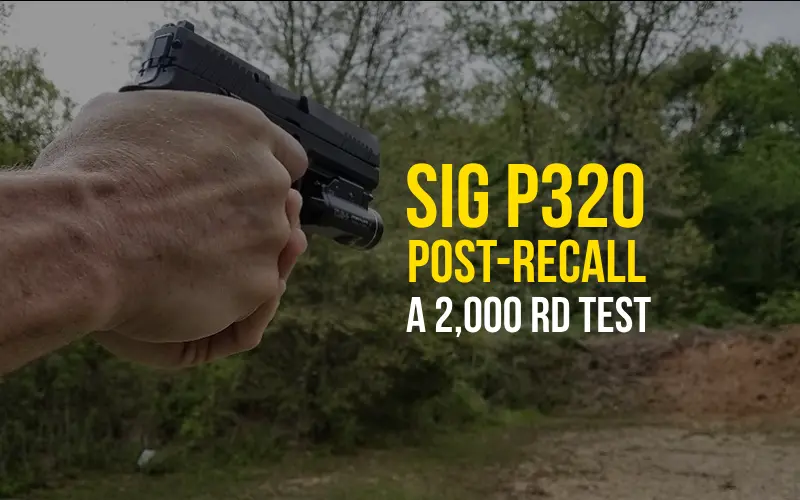
By Kip Staton
I am not a gear geek. I quit pursuing the latest and greatest guns and AR accessories when I discovered I like shooting more than collecting. I’ve got one primary handgun and rifle, with a Ruger Predator thrown in when I need something accurate to review a scope.
So, it was a big step for me to purchase a brand-new, full-sized Sig Sauer P320. My old standby Glock 19 was reserved for carry only for a time, while I switched my daily range sessions to what’s rapidly become the SIG Sauer flagship handgun.

I usually like to stick with what I find works, and not change anything after that. However, the U.S. Army obviously thinks something of the gun, and many large police departments have either made the switch to the P320 or intend to. This makes the gun interesting to me. I also wanted to get some experience on a handgun that wasn’t my Glock 19.
I value other perspectives, and I figured that changing up my daily shooter might provide an edge that could translate through to better marksmanship. My P320 was purchased out of my own pocket, if that sort of thing matters to you.
Ultimately, I fired 2,000 rounds through the pistol over the course of this review. Long story short – it’s a fantastic gun, based on the exhibited reliability, accuracy, shootability and ease of maintenance. Bottom line: I would trust the gun enough to carry it.
Sig Sauer P320 Series Overview
Historically, the P320 is on the whole not a new concept or design. Originally introduced in 2007 as the modular P250, sales were slow for a variety of reasons. Shooters just weren’t a fan of the double-action only hammer-fired design, and to be frank, marketing also needed quite a bit of help. While the P250 introduced the innovative concept of a modular, serialized sub-frame, it remained little more than a novelty for several years.
All that changed with the introduction of the P320. The slide received some more attractive contouring, and the long double-action only trigger pull was replaced with a short, crisp striker-fired design. Marketing significantly improved, shooters began to take notice, and the P320 was launched into the mainstream.
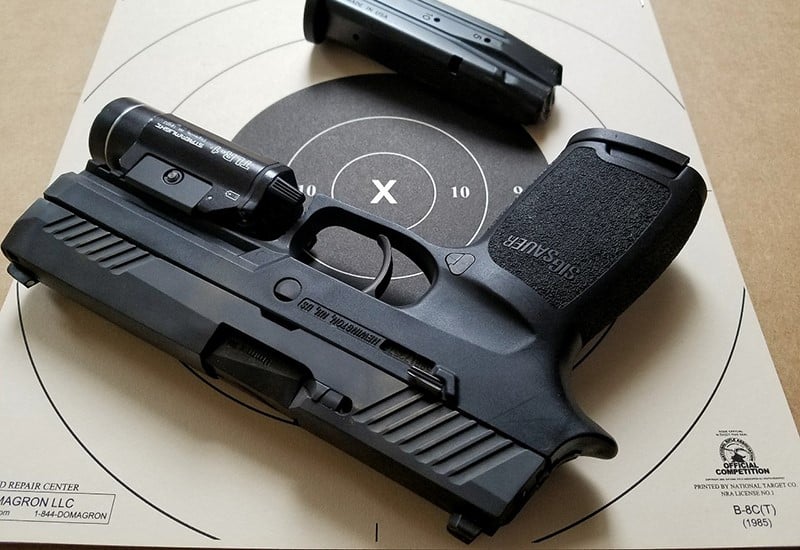
The line has since expanded into different calibers, frame sizes, barrel lengths and configurations, including models with slides pre-cut for optics. Most notably, the US Army also chose the pistol to replace their aging stock of Beretta M9s as the M17/M18, amid a storm of controversy. The pistol has also had its fair share of troubles, including a voluntary recall related to discharges when the pistol was dropped in a certain way.
My P320 is a post-recall model, equipped with the updated, physically lighter trigger and slide modifications. I’m not going to go into the details surrounding the recall; that topic has been covered elsewhere ad nauseum. For now, it seems that it’s smooth sailing for the P320.

SIG SAUER P320 9mm Pistol
$479.99
Price accurate at time of writing
- Action: Semi-Auto
- Caliber: 9mm Luger
- Barrel length: 4.7"
- Capacity: 17rd
- Safety: No Manual Safety

SIG SAUER P320-M17 9mm Pistol
$649.99
Price accurate at time of writing
- Action: Semi-Auto
- Caliber: 9mm Luger
- Barrel length: 4.7"
- Capacity: 17rd
- Safety: With Manual Safety
Sig P320 Modularity
One of the big selling points of the P320 series is the very modular design. The actual “firearm” part of the P320 is a cleverly designed stainless steel frame that sits inside a polymer shell, and accepts a slide.
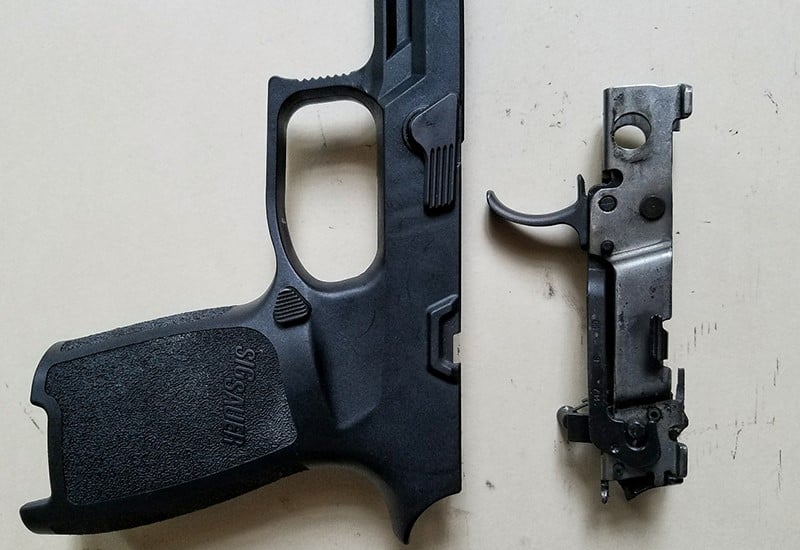
This means that once you purchase a single P320, switching your pistol from a full-size model to a sub-compact carry gun is as easy as field stripping and swapping parts around. Furthermore, extra frames in different grip sizes (small, medium and large) and colors are readily available for around $40.
Since frames and slides aren’t a controlled item, you can essentially get a different pistol without having to ship anything to your FFL. Another benefit I found to the modular design is that maintenance on the gun is simple and straightforward. I don’t do it often, but the P320 is very easy to get very clean!
Sig Sauer P320 Sights and Controls
I elected to purchase a P320 with standard three-dot contrast sights. They’re compatible with standard P226 sights, which means there’s a healthy aftermarket in place. I will probably swap them out in the future for something that gets rid of some of those dots, but I’m not in a huge hurry. At least they’re made of metal.
The sights (on my pistol, at least) were regulated to shoot point of aim/point of impact at 25 yards. It took some time to grow accustomed to holding at the top of the bullseye, instead of 6 o’clock, but it’s not a big deal.
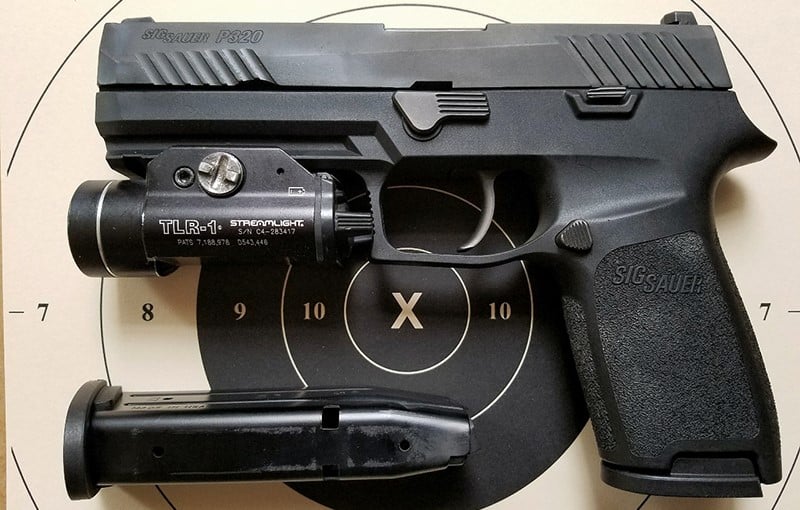
Much discussion on the P320 has centered on the quality of the trigger. Often touted as “the finest trigger ever put in a striker-fired handgun,” the trigger of the P320 is indeed above average, as compared to just about everything else in its category. I don’t necessarily care too much about the “quality” of a trigger on a gun like this, but it is quite nice.
There’s a short period of takeup, prior to hitting the “wall.” Once enough pressure is applied for the striker to release, there is little to no movement afterwards. Reset is fine, at which point the process can begin again.
I haven’t found the trigger to be the limiting agent in my ability to shoot the gun at speed. I can regularly keep an entire magazine of ammunition within the 9-ring of a B-8 repair center at 7 yards, with splits in the .30-.35 range. At it certainly isn’t the problem with my slow-fire scores at 25 yards. It’s a respectable trigger, and for what it’s worth, I like it.
The magazine release is reversible, to either the right or left hand side. A paperclip or similar instrument is required to shift it over. As far as the takedown lever goes, it’s a low-profile affair that takes some thumb strength to activate, but swings down when the slide is to the rear. The pistol does not require a trigger press to disassemble.
* Prices accurate at time of writing
Sig P320 Reliability
It doesn’t really matter how accurate or easy to shoot a pistol is if it won’t run. To check the Sig P320’s reliability, I took the fresh pistol out of the box, and cleaned and lubricated it according to the manual.
I then proceeded to shoot 1,000 rounds of 124 grain Speer Lawman and 1,000 rounds of 115 grain UMC ammunition through the handgun, without further cleaning or lubrication. This number was arrived at based on the late Todd Green’s writings on the subject of reliability. I have a tremendous amount of respect for the work Mr. Green did in the world of pistol shooting, and consider his 2,000 round standard to be both realistic and sufficient for testing the general reliability of an individual handgun.
At round 833, the pistol successfully extracted the spent casing, and failed to fully feed the next cartridge. The slide somehow skipped or missed picking up the next cartridge, and slid over the rim, jamming the bullet nose into the chamber. This occurred while shooting the 115 grain UMC ammunition, and was easily cleared by simply pulling the slide back slightly and letting it go home.

That same type of malfunction was repeated again at round number 1,688, this time using the 124 grain Speer Lawman ammo. Incidentally, the same magazine was in use when the failures occurred. I’m not sure if it’s the magazine’s fault, but I’m watching it now.
All in all, those were the only failures of the pistol to complete the entire cycle of operation during firing, for the combined total of 2,000 rounds. Magazines used were the two OEM units included with the handgun. Incidentally, they feature a 17 round capacity and are made of steel. Here they are, with 1,000 rounds of grime and wear on each one:
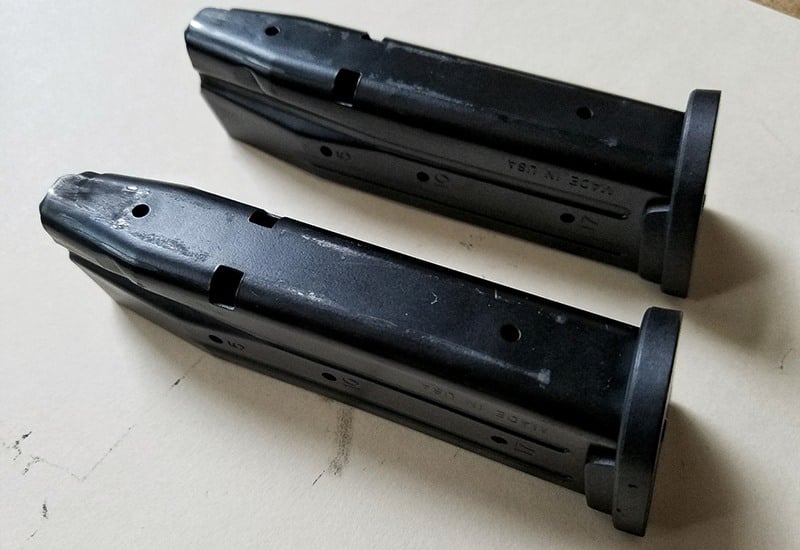
I did not shoot any defensive ammunition from the handgun, as my Glock 19 is going to remain my carry gun for the foreseeable future. Based on the performance with Speer Lawman training ammunition that supposedly mimics Speer duty ammunition, I don’t foresee any issues rising up.
All shooting was done with a Streamlight TLR-1 mounted underneath the front rail, with the correct Picatinny insert installed. This light will live on my pistol pretty much 100% of the time, so I was curious to see if it would affect anything. Would my P320 have fared differently as far as reliability goes with no light mounted? I don’t know. It passed with the light, so take from that what you will.
This is one of the main points I want to emphasize about the Sig Sauer P320: It’s reliable. Not 100% in my case, but enough so that I would carry it. Or at least that’s the case within my sample of one pistol and two different ammunition types, with differing bullet weights.
Is two malfunctions in 2,000 rounds appropriate, with one cleaning and lubrication session at the very start? I’ll let you be the judge of that.
Sig Sauer P320 Accuracy
This is an extremely accurate pistol. Accuracy before and after the 2,000 round test was identical; there was no noticeable degradation from start to finish.
My standard daily range sessions start out with one (or more) string of 10 rounds, slow-fired offhand at 25 yards on a standard NRA B-8 repair center. I strive to shoot a score of 90 or better each time, out of a possible 100 points.
Over the first 500 rounds slow-fired at 25 yards, my 10-shot scores averaged 91 points. I’m pretty happy with that, from a standing unsupported position. The inherent practical accuracy is certainly “good enough”, especially at my skill level. It may shoot better with match grade ammunition, but I’m happy with a gun that will print a 90+ most of the time on a 25 yard B-8 target, freehand.
Speed Drills with the Sig P320
What about the P320’s shootability at a fast pace? My favorite quick drill for speed and accuracy is Ken Hackathorn’s “The Test.” It’s simple, short, and can tell you a lot about your shooting abilities very quickly.
The drill itself is simple: Fire 10 shots, at 10 yards, in under 10 seconds, from the low ready on a B-8 repair center. A score of 90 or above is required to pass the drill. Here’s a typical example of five runs for me, with no warm-up:
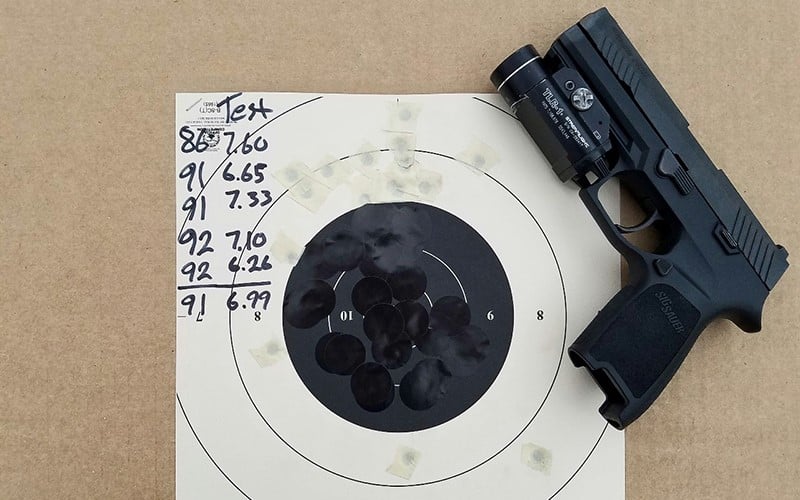
The black 9-ring is only 5.5” across, and it’s trickier than it looks. I always run this drill cold, if possible, or immediately after my 25 yard slow fire drills. With the Sig P320, my average scores early on through my two cases of ammo held right around 90-94 points and seven seconds, easily meeting the passing standard. That’s good enough for me!
Many shooters complain about the high bore axis on Sig pistols. A higher bore axis provides a longer relative lever for the recoil of the bullet leaving to push against, in theory creating a more exaggerated muzzle flip. I’ve never really found it to be an issue.
I personally don’t really care how high the muzzle comes up. While the detrimental physics of a high bore axis look good on paper, I’ve found that they seldom translate to the real world in any meaningful way, in terms of making the gun harder to shoot.
What’s more important to me than how much the muzzle rises is how fast the muzzle comes down. And that’s largely a function of technique (and yes, partly your pistol and ammunition combination).
Ultimately, my timed scores are very comparable to my old standby Glock 19, if not a bit better most of the time. Those are just the facts, born out by a shot timer and an actual scored B-8 target. The numbers over 2,000 rounds of experience say I shoot better with a Sig P320, as much as I may not want to admit it.
Maintenance
Obviously, the Sig P320 is a very easy to maintain pistol. Mine went 2,000 rounds without a cleaning or lubrication, but that doesn’t mean you should necessarily ignore upkeep completely. Fieldstripping the gun for basic care and maintenance is very easy to do. Here’s 2,000 rounds of grime, waiting to be cleaned:
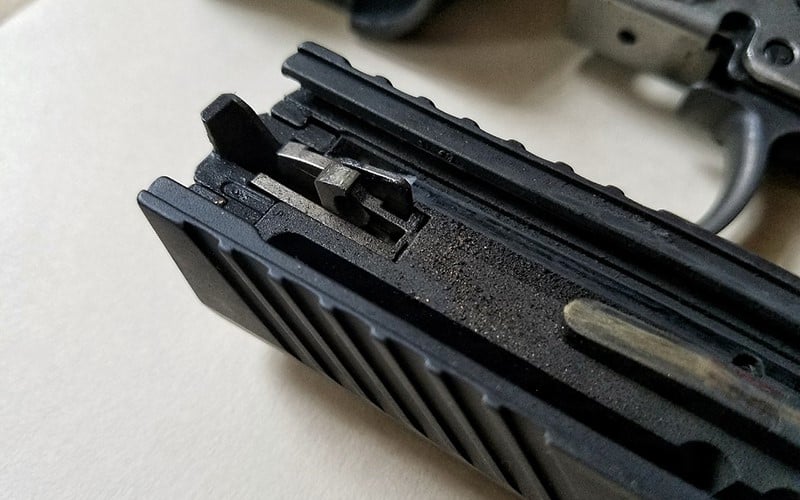
I didn’t realize just how much I would appreciate the easy-takedown feature of the frame. The serialized chassis pops out of the gun intact with a simple removal of the takedown lever, and is very easy to hose down with an aerosol gun cleaning agent. No tools are required.
* Prices accurate at time of writing
Sig P320 Aftermarket Support
I’m used to cheap Magpul Glock mags, so seeing the total price tag on what it would take to stock up on a decent number of P320 mags wasn’t fun. I like to spend my time at the range shooting, and not loading mags, so this is a hard pill to swallow. But it is what it is. Mag pricing is, for the most part, comparable to competing full-sized duty pistols that don’t say Glock on the slide.
The unique nature of the serialized fire control group lends itself to some interesting concepts. At least one company has introduced the idea of a carbine-style chassis system that the trigger cassette can drop into, giving you a nifty little carbine without involving another gun purchase.
Because the grip frame themselves are an inexpensive non-controlled part, the P320 allows easy access to custom stippled frames, through numerous vendors. No shipping of any firearms is necessary, which is pretty cool.
Is the Sig P320 Fullsize Suitable for You?
There has been a significant level of drama involved with the P320, especially recently. The Army selected the pistol over Glock’s offering, and the other military branches are following suit. Combined with a “voluntary” safety recall, the Sig P320 has been a gun blogger’s dream story for getting those precious clicks.

Despite all of that, my findings after 2,000 rounds have shown it to be an extremely accurate, soft-shooting full-sized handgun that is also very reliable. It’s affordability, combined with the convenience of the modular trigger unit, would make it a great choice for anybody that wants to standardize their compact and full-size handguns on a single base model.
You could say it’s been a bumpy road for the Sig Sauer P320, but it’s not the first military and police duty weapon to have experienced a bit of a rocky start. But it seems that things have smoothed out, and I would highly suggest considering the Sig Sauer P320 if you’re in the market for a new full-sized duty pistol.











Leave a Reply